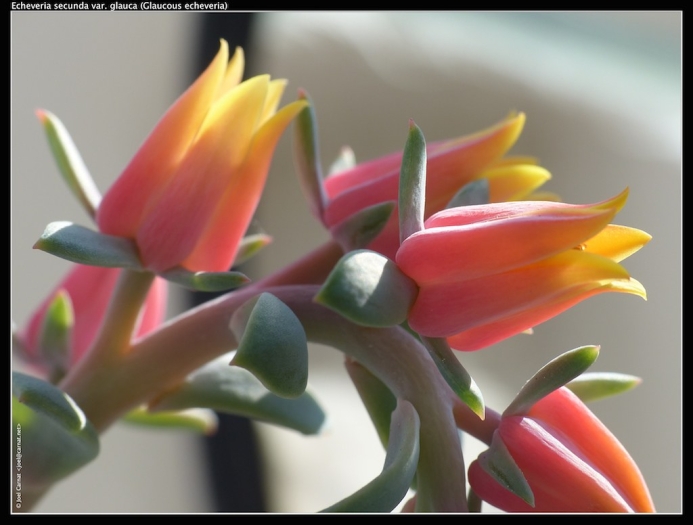Copper Rose
(Echeveria secunda)
Copper Rose (Echeveria secunda)
/
/

Carnat Joel
CC BY 2.0
Image By:
Carnat Joel
Recorded By:
Copyright:
CC BY 2.0
Copyright Notice:
Photo by: Carnat Joel | License Type: CC BY 2.0 | License URL: https://creativecommons.org/licenses/by-sa/2.0/ | Uploader: Joel Carnat | Publisher: Flickr |













Estimated Native Range
Summary
Echeveria secunda, commonly known as Copper Rose, is a perennial succulent native to rocky outcrops and semi-desert regions in Mexico. It has also been introduced to the Dominican Republic, New Zealand, and Vietnam. This plant typically forms a rosette up to 8 inches (20 cm) in diameter, with glaucous, blue-green leaves that can take on a coppery hue when stressed. Echeveria secunda blooms in the late spring to early summer, producing pink to red flowers with yellow tips on tall, arching inflorescences that are quite showy against the foliage.
The Copper Rose is valued for its low maintenance and drought tolerance, making it a favorite among succulent enthusiasts. It is often used in rock gardens, container displays, and as ground cover in xeriscaped areas. Its ability to thrive with minimal water and its preference for well-draining soil make it an excellent choice for water-wise gardening. The cultivar ’Compton Carousel’, with its variegated leaves, has gained the Royal Horticultural Society’s Award of Garden Merit, indicating its exceptional performance in gardens. While Echeveria secunda generally requires little care, it is susceptible to overwatering, which can lead to root rot. It is also prone to mealybugs and aphids, which can be managed with appropriate pest control measures.CC BY-SA 4.0
The Copper Rose is valued for its low maintenance and drought tolerance, making it a favorite among succulent enthusiasts. It is often used in rock gardens, container displays, and as ground cover in xeriscaped areas. Its ability to thrive with minimal water and its preference for well-draining soil make it an excellent choice for water-wise gardening. The cultivar ’Compton Carousel’, with its variegated leaves, has gained the Royal Horticultural Society’s Award of Garden Merit, indicating its exceptional performance in gardens. While Echeveria secunda generally requires little care, it is susceptible to overwatering, which can lead to root rot. It is also prone to mealybugs and aphids, which can be managed with appropriate pest control measures.CC BY-SA 4.0
Plant Description
- Plant Type: Succulent
- Height: 0.3-0.5 feet
- Width: 0.3-0.5 feet
- Growth Rate: Slow
- Flower Color: Yellow, Orange, Pink, Red
- Flowering Season: Spring
- Leaf Retention: Evergreen
Growth Requirements
- Sun: Full Sun, Part Shade
- Water: Very Low, Low
- Drainage: Fast
Common Uses
Bird Garden, Border Plant, Drought Tolerant, Fire Resistant, Groundcover, Hummingbird Garden, Low Maintenance, Potted Plant, Rock Garden, Showy Flowers, Street Planting
Natural Habitat
Native to rocky outcrops and semi-desert regions in Mexico
Other Names
Common Names: Marmol, Maroon Chenille Plant, Painted Lady, Flor De Marmol
Scientific Names: , Echeveria glauca, Echeveria secunda, Echeveria pumila, Echeveria secunda var. glauca, Echeveria elatior, Echeveria alpina, Echeveria pumila var. glauca, Cotyledon glauca, Cotyledon secunda
GBIF Accepted Name: Echeveria secunda Booth ex Lindl.